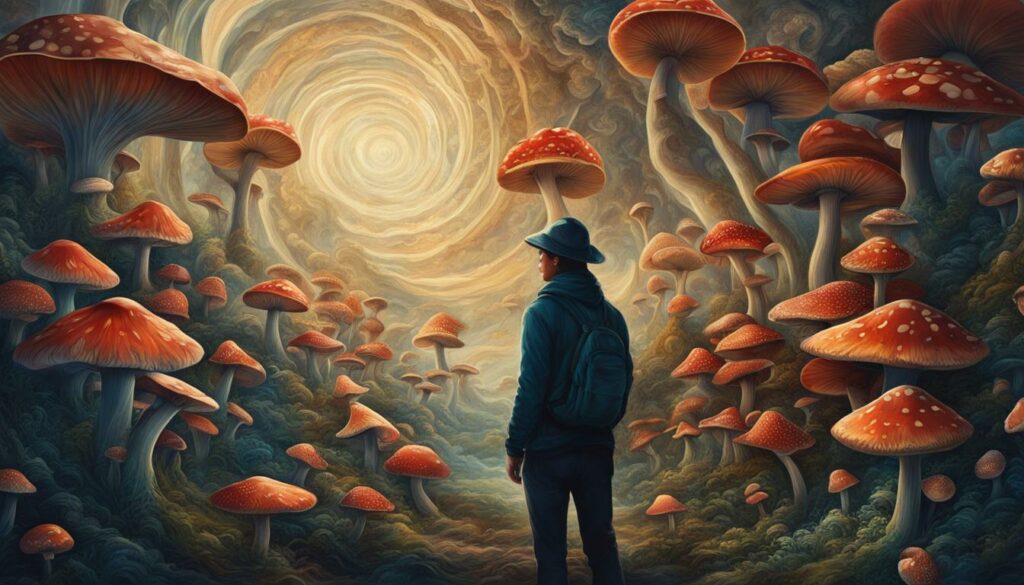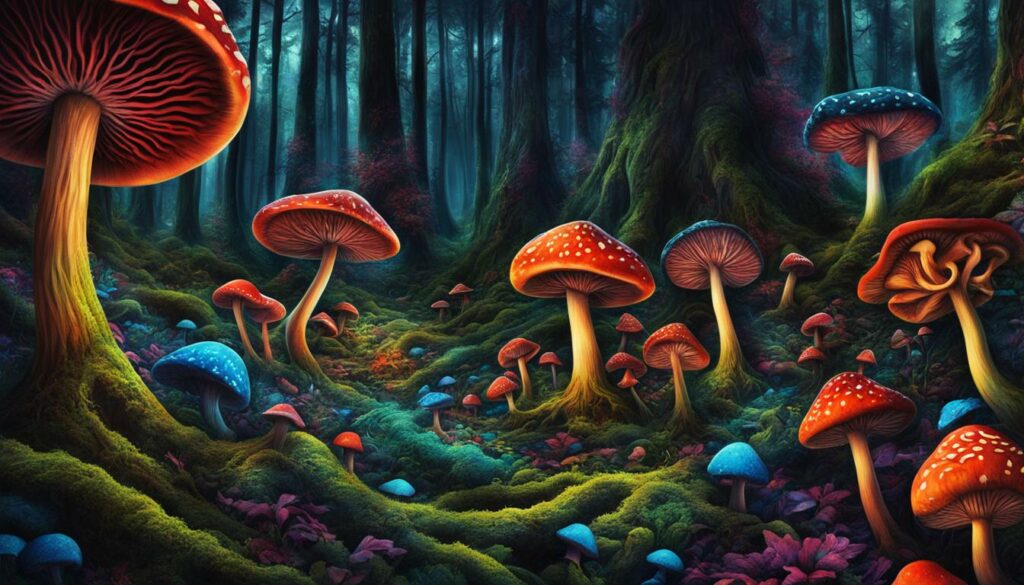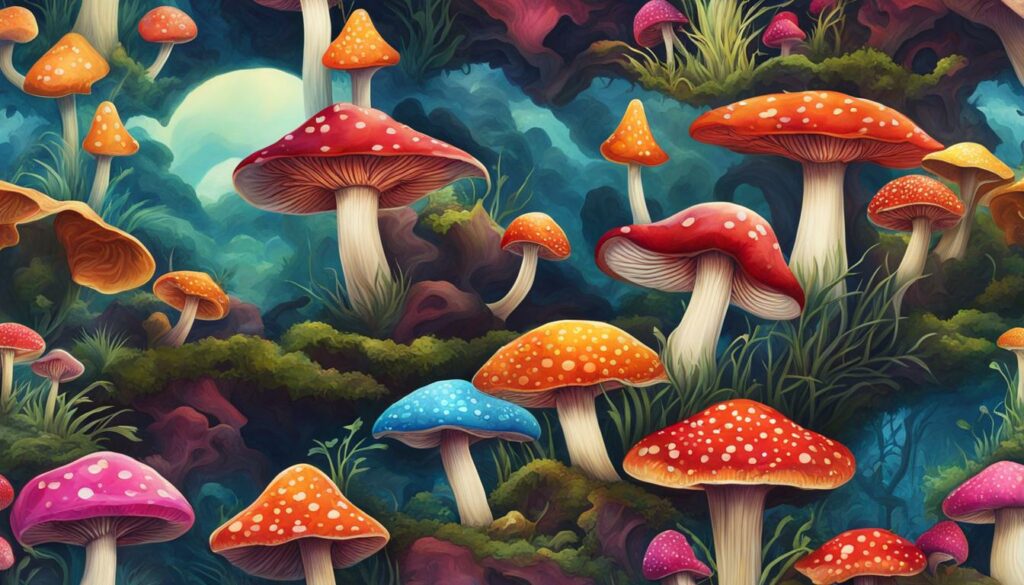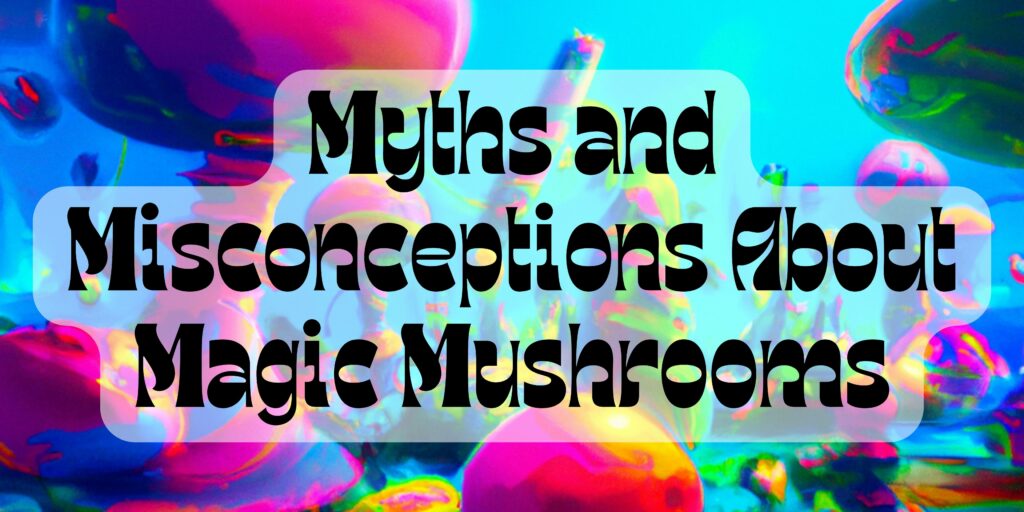Welcome to our comprehensive guide on understanding how long a shrooms high lasts. If you’ve ever wondered about the duration of the effects, detection in drug tests, or factors that can influence the duration of a shroom trip, you’ve come to the right place. In this article, we will explore everything you need to know about shrooms and their effects on the body.
Key Takeaways:
- The effects of taking shrooms can last 3 to 6 hours, depending on various factors.
- Psilocybin, the psychoactive compound in shrooms, can stay in the system for up to 24 hours.
- The detection window for shrooms in drug tests varies, and specialized tests may be able to detect them.
- Factors such as dosage, species of mushroom, method of use, and other substances consumed can affect the detection of shrooms in the system.
- Drinking water or other methods to flush out shrooms from the system faster are not effective.
How Long Does a Shroom Trip Last?
The duration of a shroom trip can vary, but it typically lasts between 3 and 6 hours. Upon ingestion, the effects of shrooms are usually felt within 30 minutes, although this timeframe may vary depending on the method of consumption. Factors such as the dosage, species of mushroom, method of consumption (whether dried or fresh), age, tolerance, expectations, and the presence of any preexisting mental health conditions can all influence the duration and intensity of a shroom trip.
While the majority of the trip occurs within the first few hours, some individuals may experience lingering effects that persist into the next day. However, within 24 hours, most people return to their normal state. It’s important to note that the effects of shrooms can be highly subjective and vary significantly from person to person.
To gain a better understanding of the duration of a shroom trip, it is helpful to consider the experience in stages. The onset of effects typically marks the beginning of the trip, followed by the peak, where the effects are at their most intense. After the peak, the effects gradually begin to diminish, leading to the comedown phase. Each of these stages can contribute to the overall duration of the trip, with the entire experience lasting up to 6 hours.
The Stages of a Shroom Trip
- Onset: This stage, occurring approximately 30 minutes after ingestion, is when the initial effects of shrooms begin to be felt.
- Peak: The peak of a shroom trip is the most intense period, where hallucinations, altered perception, and changes in mood and thoughts are at their strongest. The peak typically lasts for 2 to 3 hours.
- Comedown: After the peak, the effects of shrooms gradually subside, and individuals may experience a sense of relaxation or fatigue. This stage can last for a couple of hours before returning to a baseline state.
It’s important to approach a shroom trip with caution and in a safe environment. The effects of shrooms can be unpredictable, and it’s advisable to have a trusted individual present who can provide support if needed. Additionally, it’s important to be aware of the potential risks and side effects associated with shroom use, especially for individuals with preexisting mental health conditions.
By understanding the duration of a shroom trip and being prepared for the stages and potential effects, individuals can have a more informed and enjoyable experience. However, if someone is experiencing severe distress or prolonged negative effects during a trip, it is advisable to seek professional help.
Factors Affecting Shroom Detection in the System
Various factors can influence how long shrooms stay in the system and are detectable in drug tests. These factors include the time between ingestion and testing, the species of mushroom consumed, the method of use, the dosage, age, metabolism, body composition, the presence of food in the stomach, and the use of other substances.
Typically, shrooms are eliminated from the body within 24 to 48 hours. However, metabolites of the drug can be detected for up to 90 days in hair follicle tests. It’s important to note that while routine drug tests, such as urine tests, do not usually detect shrooms, specialized tests may be able to detect the presence of the drug.
Standard 5-panel drug tests, commonly used by employers, do not typically include shrooms in the panel. Drinking water or using other methods to expedite the elimination of shrooms from the system does not significantly impact the detection of the drug. It’s important to be aware of the detection window for shrooms in specialized tests and to consider the potential consequences of shroom use when facing drug tests.
| Factors | Impact on Shroom Detection |
|---|---|
| Time between ingestion and testing | Affects the likelihood of detection |
| Species of mushroom | Can impact the detectability in specialized tests |
| Method of use | Can influence the detection window |
| Dosage | Affects the concentration of detectable metabolites |
| Age and metabolism | Individual factors that can impact detection |
| Body composition | Can affect the rate of elimination |
| Presence of food in the stomach | May impact the absorption and detection of shrooms |
| Use of other substances | Can interact with shrooms and affect detection |
Effects of Shrooms and Duration
When consuming magic mushrooms, also known as shrooms, users can experience a range of effects that typically last for 3 to 6 hours. These effects can include euphoria, altered perception, hallucinations, changes in thoughts or mood, and alterations in heart rate and body temperature. Other physical manifestations may include headaches, nausea, sweating, chills, flushing, and dilated pupils. It’s important to note that the intensity and duration of these effects can vary based on several factors.
The duration of a shroom trip is influenced by factors such as the dosage, the species of mushroom consumed, the method of consumption (whether dried or fresh), the user’s age, tolerance level, expectations, and the presence of any preexisting mental health conditions. All of these factors can contribute to how long the effects of shrooms last. Some individuals may experience lingering effects into the next day, but within 24 hours, most people generally return to their normal state.
It’s worth mentioning that a shroom trip may not always be a positive experience. Some individuals may encounter anxiety, depression, headaches, or feelings of exhaustion. Additionally, flashbacks of previous trips can occur, lasting up to 2 minutes. The severity and duration of these effects can be impacted by factors such as dosage, the species of mushroom consumed, method of consumption, age, tolerance level, expectations, and the presence of any preexisting mental health conditions.
Overall, understanding the effects and duration of shrooms is crucial for individuals considering their use. It’s important to approach shroom consumption with caution, taking into account personal factors and potential risks. If someone finds themselves struggling with a shroom trip or experiencing severe distress or prolonged negative effects, it is advisable to seek professional help.

| Factors Affecting Shroom Effects and Duration | Duration | Severity |
|---|---|---|
| Dosage | 3-6 hours | Varies |
| Species of Mushroom | 3-6 hours | Varies |
| Method of Consumption | 3-6 hours | Varies |
| Age | 3-6 hours | Varies |
| Tolerance Level | 3-6 hours | Varies |
| Expectations | 3-6 hours | Varies |
| Presence of Preexisting Mental Health Conditions | 3-6 hours | Varies |
Detection of Shrooms in Drug Tests
When it comes to detecting the presence of shrooms in drug tests, routine urine tests, commonly used by employers, do not typically detect shrooms. The metabolites of shrooms are usually eliminated from the urine within 24 to 48 hours, making them undetectable for most standard drug tests. However, it’s important to note that specialized urine tests may be able to detect shroom metabolites for up to a week after consumption.
While urine tests are the most common method of drug testing, hair follicle tests have a longer detection window for shrooms. These tests can detect shroom metabolites for up to 90 days, providing a much larger window for detection compared to urine tests. Blood tests and saliva tests are less commonly used for shroom detection, but they can detect the presence of shrooms within specific time frames after consumption.
It’s important to consider that specialized drug tests for shrooms can be costly and are typically only administered when there is strong evidence of shroom use. Therefore, for most routine drug tests, the chances of shrooms being detected are quite low. However, it’s always important to be aware of the specific drug testing policies and procedures in your workplace or any other relevant settings.
Table: Shroom Detection Time in Different Drug Tests
| Drug Test | Detection Window |
|---|---|
| Urine Test | Up to 1 week with specialized tests |
| Hair Follicle Test | Up to 90 days |
| Blood Test | Several hours to a few days |
| Saliva Test | Up to 1-3 days |
As with any substance use, it’s important to approach shrooms with caution and be aware of the potential risks and side effects. If you or someone you know is struggling with shroom abuse or addiction, seeking professional help is recommended.
How to Handle a Bad Shroom Trip
Experiencing a bad shroom trip can be unsettling, but there are strategies you can try to ease discomfort and navigate through it. It’s important to remember that feeling uncomfortable during a shroom trip is not always a negative experience, as it can lead to personal introspection and conversations with oneself. However, if you find yourself experiencing severe distress or prolonged negative effects, it’s advisable to seek professional help.
Here are some techniques that may help alleviate discomfort during a bad shroom trip:
- Listen to calm music: Playing soothing or familiar music can help create a calming environment and shift your focus away from any negative thoughts or sensations.
- Get fresh air: Step outside or open a window to get some fresh air. Breathing in the fresh air can help clear your mind and provide a sense of grounding.
- Take deep breaths: Practice deep breathing exercises to help slow down your heart rate and induce a sense of relaxation.
- Lay down with eyes closed: Find a comfortable place to lie down, close your eyes, and try to relax your body. This can help reduce feelings of anxiety and allow you to focus on your internal experience.
- Meditate: Engaging in mindfulness or meditation techniques can help redirect your thoughts and promote a sense of calmness and clarity.
- Consume citrus juice: Drinking citrus juice, such as orange or lemon juice, may help alleviate an upset stomach that can sometimes occur during a shroom trip.
Remember to approach a bad shroom trip with compassion and self-care. It’s essential to create a safe and supportive environment for yourself, whether you choose to explore the trip or seek assistance from a trusted friend or professional.

Expert Insight:
“When faced with a challenging shroom trip, it’s important to engage in grounding techniques such as deep breathing, finding a quiet and safe space, and reminding yourself that the effects will eventually subside. Remembering that the discomfort you’re experiencing is temporary can help you navigate through the trip more easily.” – Dr. Jasmine Thompson, PsyD
Conclusion
Understanding the duration of a shrooms high is crucial for individuals considering or using magic mushrooms. The effects typically last between 3 and 6 hours, depending on various factors such as dosage, species of mushroom, and method of consumption. It’s important to note that the onset of effects can be felt around 30 minutes after ingestion.
In terms of detection in the system, shrooms are usually eliminated within 24 to 48 hours. Routine drug tests, like urine tests, do not typically detect shrooms. However, specialized tests may detect shroom metabolites in urine for up to a week, while hair follicle tests can have a detection window of up to 90 days.
It’s essential to approach shroom use responsibly and be aware of potential risks and side effects. If someone is struggling with shroom abuse or addiction, seeking professional help is highly recommended. Remember, your well-being and safety should always be a priority when using any substance.
FAQ
How long does a shroom trip last?
The effects of taking shrooms can last 3 to 6 hours, with the duration depending on factors such as dosage, body composition, and the specific species of mushroom.
How long does psilocybin stay in the system?
Psilocybin, the psychoactive compound in shrooms, can stay in the system for up to 24 hours.
Can shrooms be detected in drug tests?
Most routine drug tests cannot detect shrooms, but specialized tests may be able to. Factors such as the time between ingestion and testing, the mushroom species, the method of use, the dose, age, metabolism, and other substances consumed can all affect the detection of shrooms in the system.
How do factors affect the duration of a shroom trip?
Factors such as dosage, the species of mushroom, the method of consumption (dried or fresh), age, tolerance, expectations, and the presence of any preexisting mental health conditions can influence the duration and intensity of a shroom trip.
How long do shrooms stay in the system?
Shrooms are typically eliminated from the body within 24 to 48 hours, but the detection window for shrooms in drug tests varies. Hair follicle tests, for example, can detect shroom metabolites for up to 90 days.
What are the effects of shrooms and how long do they last?
The effects of shrooms can include euphoria, altered perception, hallucinations, altered thoughts or mood, changes in heart rate and body temperature, headache, nausea, sweating, chills, flushing, and dilated pupils. These effects typically last for 3 to 6 hours, with some effects potentially lasting up to 24 hours.
Can a bad shroom trip be handled?
Strategies that individuals can try to ease discomfort during a bad shroom trip include listening to calm music, getting fresh air, taking deep breaths, laying down with eyes closed, meditating, or consuming citrus juice to alleviate an upset stomach. If someone is experiencing severe distress or prolonged negative effects, it’s advisable to seek professional help.




